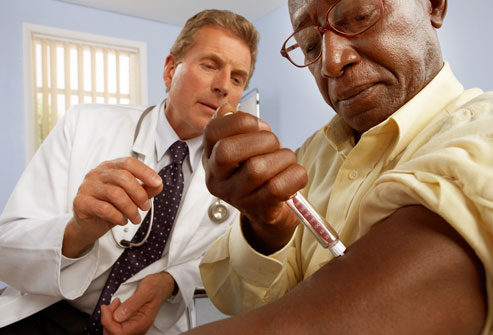Insulin-independent diabetes curing using stem cell
What is non-insulin-dependent diabetes mellitus?
 It is also called type II diabetes. And it occurs as a rule in persons after 40. As the function of beta cells partially or fully preserved, the majority of patients do not require insulin treatment. This is the reason why diabetic ketoacidosis is rare among persons diagnosed with disease. 80% of such patients suffer from obesity. The way the patients feel during non-insulin-dependent diabetes mellitus differs considerably from the state when he is diagnosed with insulin-dependent one. The disease progresses slowly in the first case, while the complications appear much later. The risk that your close relatives will also have it is 50%, but as far as insulin dependent type is concerned, it is 10%.
It is also called type II diabetes. And it occurs as a rule in persons after 40. As the function of beta cells partially or fully preserved, the majority of patients do not require insulin treatment. This is the reason why diabetic ketoacidosis is rare among persons diagnosed with disease. 80% of such patients suffer from obesity. The way the patients feel during non-insulin-dependent diabetes mellitus differs considerably from the state when he is diagnosed with insulin-dependent one. The disease progresses slowly in the first case, while the complications appear much later. The risk that your close relatives will also have it is 50%, but as far as insulin dependent type is concerned, it is 10%.
Type II diabetes is rather common case. There are over 100 million people globally who have it. It is mostly spread among people of developed countries, living in the cities. 8% of white people in the USA have it.
Who is affected?
Some forms of type II diabetes develop because of genes defects, which become the cause of the problem. There are some factors due to which people have predisposition to the disease: obesity, wrong nutrition, stress, lack of physical activity.
Symptoms of insulin-independent diabetes
Some patients do not have visible signs of this disease. Sometimes the symptoms are so mild that you just do not pay attention to them. It is considered that over 5 million of Americans are not aware about the problem.
When the person is on the early stage of the illness he may have chronic fatigue and general weakness. The person urinates frequently and feels thirst. There can be problems with vision too.
So the problems that can arise are:
- Lethargy
- Sudden weight loss
- Itching of genitalia
- Weakness
- Frequent urination
Noninsulin-dependent diabetes mellitus treatment
This is a chronic case that progresses with time and requires treatment, but there is no established cure for it. In spite of it there are established treatments that can effectively help patients diagnosed with insulin independent diabetes. Besides, the condition is progressive when the management of blood sugar is poor. When it is not managed then serious complications are possible.
In a short timeframe high glucose level can be acquired though this is more common for type 1 diabetes.
Among long-term complications are:
- Nerve damage
- Atheroma
- Kidney damage
- Problems with vision
- Impotence
- Foot problems
Every case is unique and there can be different complications in patients. In case the level of glucose is too low, hypoglycemia can occur. It can be under 4mmol/L. A hypo can occur to people who take much medications, eat with delay or miss a meal, had unplanned physical activity.
When person has hypoglycaemia, he may have the following symptoms:
- Trembling
- Anxiety
- Sweating
- Blurred vision
- Confusion
- Changes of mood
- Paleness
In order to get rid of it, one should take something sweet or a sugary drink. The aims of treatment include control of glucose level, reduction of risk factors that can develop complications. When doctor helps to determine complications fast, it is easier to alleviate or stop them.
Stem cell treatment
Stem cell therapy can be the best way to manage the condition of the patient who is diagnosed with type 2 diabetes mellitus. Right treatment will help you to cope with the case and refuse from medications that are prescribed for diabetics.
Stem cell injections can give you the freedom and better health because medications and poor management of the disease can ultimately ruin your health. It is easier to solve the problem once that do it on a daily basis, though constant supervision will be required still.
Even such condition as ulcerative colitis can be cured using stem cells.